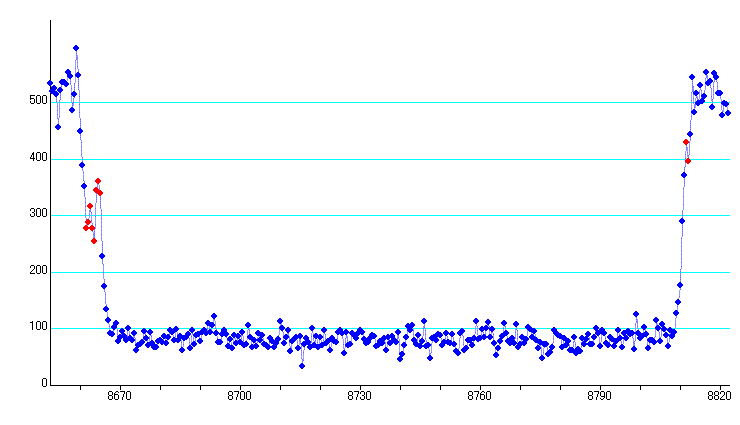
Fig.1 Luminous change of occultation event. (Observed by M.Yanagisawa and K.Gonsho)
Component of the double star TYC 1886-01206-1 found from the observation of occultation by Kalliope & Linus.
Feb.11 2007
Kazuhisa Miyashita
1. Introduction
Tsutomu Hayamizu who is a coordinator of occultation observation sent me a DV video tape which contains observation records of TYC 1886-01206-1 occultation by (22)Kalliope and its satellite Linus at Nov.07 2006 in Japan.
The reduction of occultation by Kalliope and Linus. By Sendai Space Hall
He asked me to digitize and pre-analyze it and I made DVD data disks. When I checked and analyzed it using Limovie 0.9.25, I found that the light curves of all of events have a step at the event time. It indicates TYC 886-01206-1 is double consists of two stars with almost same brightness. I tried to measure the time difference between the events of both component and to estimate component's magnitude. However, some events have a step which is higher than the half of full brightness, though it seems the both magnitude are equal. It is thought that the double star has very small angular difference, and as the result of it, the light diffraction is overlapped. The analysis with considering the diffraction effects is necessary to obtain some meaningful data.
Limovie has a diffraction feature which draws the light curve simulated by fresnel diffraction and fit to the luminous change obtained from the video clip of observation. Based on this, I improved and made a new feature to analyze the case of double star's occultation. When the prototype of this function had been completed, I analyzed the video clips. The new diffraction feature well draw the detail of the change of light curve, and well fit it to the data derived from observations. The result of this analyzing is used to calculate to the position angle, separation and magnitude. This is a report of result of this analysis.

Fig.1
Luminous change of occultation event. (Observed by M.Yanagisawa and
K.Gonsho)
The red point is the part of the step of luminous change. They indicate the target star is double.
The height of the step at reappearance is higher than at disappearance. It indicates the light of diffraction of each star are overlapped.
2. The feature of the TYC 1886-01206-1 event by Kalliope and sattelite Linus
The asteroid 's distance is 278,200,000km, the movement is 0.00445 arcsec/second, and the speed of shadow projected to Bessel's base plane is 6100m/sec. The feature of this phenomenon is the movement is slow. Therefore the luminous change is also slow and it is suitable for video photometry. Figure 1 shows the luminous change of this event. The light curve forms a step which has half height of intensity of full brightness at disappearance, and it has step of three quarters height at the reappearance. At the disappearance, the time difference about 10 fields (about 170 milliseconds) are observed. However, at the re-appearance, it is difficult to obtain the time difference because the light of diffraction is overlapped. Then, to analyze accurately the time difference , I produced Limovie's new function named “Double star analysis”.
3. Diffraction Simulation
(1) Principle of diffraction fitting feature
If the asteroid's limb whith is perpendicular to the moving direction hide the star considerd point source, the luminous intensity and its change of occultation is given the formula:
![]() (1)
(1)
I o is luminous intensity of the star. C(ω), S(ω) is the fresnel integral given:
![]() (2)
(2)
![]() (3)
(3)
ω is fresnel number given the formula:
![]() (4)
(4)
![]() is
wave length of light, D is distance from the observatory to asteroid,
is
wave length of light, D is distance from the observatory to asteroid,
![]() is speed of the asteroid's shadow on the Bessel plane. If the star is
diagonally hidden for asteroid's edge, the speed of luminous change
is slower than the case of hiding perpendicularly to
is speed of the asteroid's shadow on the Bessel plane. If the star is
diagonally hidden for asteroid's edge, the speed of luminous change
is slower than the case of hiding perpendicularly to
edge.
![]() is the angle between the direction of edge of asteroid and the
direction perpendicular to the moving direction of asteroid. In this
text, it is called contact angle.
is the angle between the direction of edge of asteroid and the
direction perpendicular to the moving direction of asteroid. In this
text, it is called contact angle.
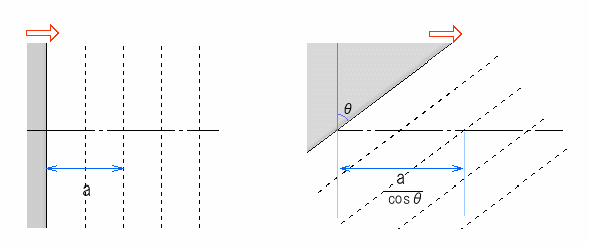
Fig.2-1
The relation between contact angle and the change speed of the
fresnel pattern.

Fig.2-2
Change of light intensity which is related to contact angle. (It is
in the case of lunar occultation.)
(2) The diffraction analyzing feature of Limovie
Limovie calculates the luminous intensity for the given time with the accuracy of one millisecond. The spectrum of light is also integrated during 400nm- 780nm to compare the data derived from CCD camera. The effect of telescope's aperture is not considered because the telescopes which is used by amateur is small enough to be negligible for calculation.
Based on this, Limovie compute an event time accurately and estimate the contact angle. It is obtained by fitting simulation to the data. These parameters are obtained by comparing it to minimize the square error margin.
As preparations for this analysis, it is necessary to set the distance of asteroid and the speed of movement of asteroid's shadow. They are obtained from roughly calculation:
Distance(km):
It
can be obtained simply using the value of “Parallax”
described to Steve Preston's prediction.
Distance = Radius
of Earth(km) / (Parallax(rad))
Parallax=4.728" =
0.001313(deg) = 0.00002292(rad)
Distance = 6,378[km] /
0.00002292[rad]) = 278,200,000[km]
Shadow's speed(m/sec):
It
is given by simple equation using the data which is predicted by
Steve Preston.
V[m]=(Diameter[km] / MaxDuration[sec]) *
1000
V=181000 / 30.1 = 6103 [m/sec]
Notice: It is an
approximate calculation. If it needs more accurate result, especially
when the movement of asteroid is slow, it must compute in
consideration of the rotation of the earth.
(3) Doublestar's phenomenon and Limovie analysis
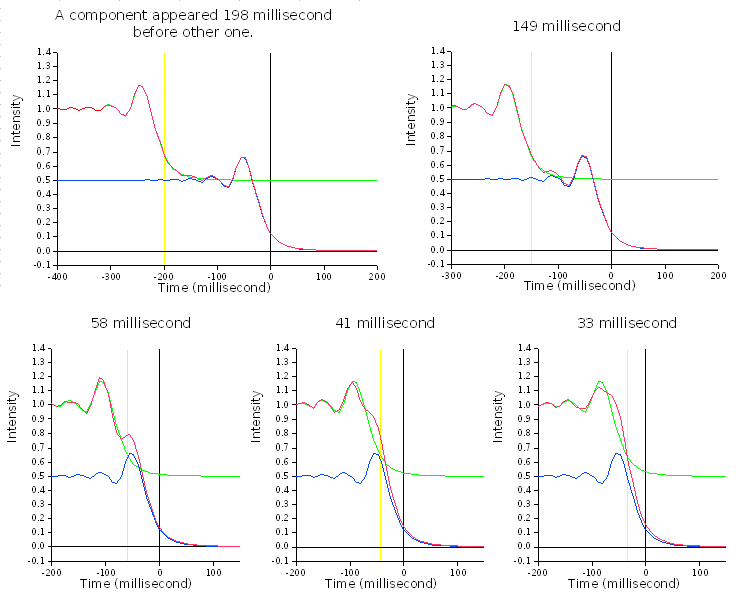
Figure
3 Simulation of luminous change at double star's occultation
Green : first disappeared component , Blue : second disappeared component , Red : double star's light curve
The graphs show the case of that asteroid's distance is 278200000km and asteroid's shadow velocity is 6100m/sec.
It was simulated assuming both components have same brightness.
When two event's time are very near, the step's height is not half of full brightness.
When the peaks are clear, time difference between two events can be estimated from the time of two peaks.
Generally,
each component of double star forms a peak clearly. However, in the
case of very close double star, the light curve forms gentle peak or
peaks and the matter makes difficulty to find the central time of
event. The new function called Doublestar Analysis of Limovie 0.9.25b
was produced to determine the event time . This function draws the
light curve with considering the effect of double star using the
parameters of the brightness ratio* of components and time difference
between two events. The repeatedly processing with change of the
setting is necessary to estimate the parameters . When the simulation
well fit to measurement value, it is considered the parameters are
true.
This
process also output the contact angle
![]() in formula(4) . It is important parameter to estimate the position
angle and separation of double star.
in formula(4) . It is important parameter to estimate the position
angle and separation of double star.
* The brightness ratio(BR) is given :
BR = Brf / Bp or BR = Bds / Bp
Brf : brightness of first re-appeared star, Bds: brightness of second disappeared star, P: brightness of pair
4. Analyzing TYC 1886-01206-1 occultation

Figure
4-1 Measurement and simulation at disappearance
Observer: M.Yanagisawa and K.Gonsho Equipment: D=450mm Newtonian , WAT100N camera gamma:OFF gain:Manual
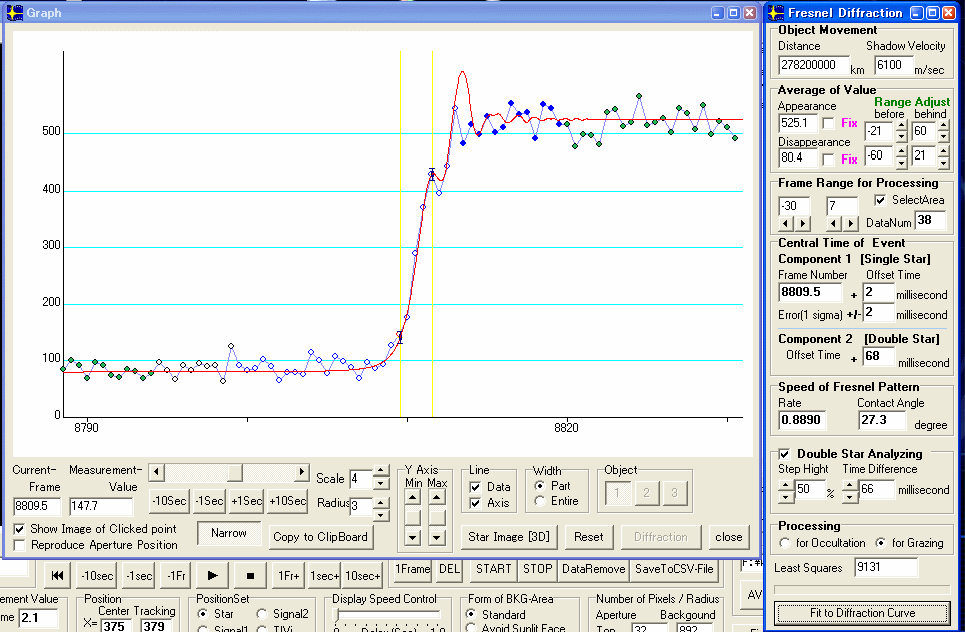
Figure.
4-2 Measurement and simulation at reappearance
This event was difficult to fit the simulation to the measurement light curve. Because the air scintillation deformed the shape of light-curve at the end of reappearance. Result of trial and error, an excellent result was obtained by narrowing the range of the selected point.
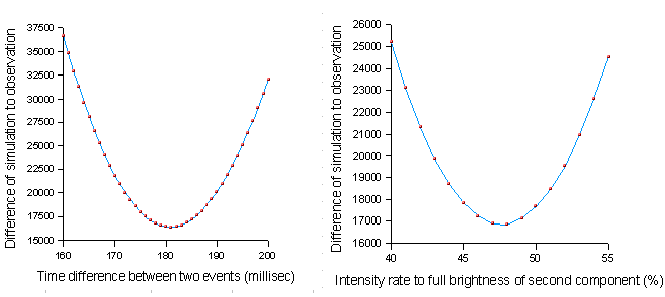
Figure
5 Fitting of diffraction pattern
Fitting to the light curve of disappearance observed by M.Yanagisawa and K.Gonsho
Left : Changing the time difference between the event os two components
Right : Changing the step's hight of second disappearanced component
Analizing each observations
The results of analysis are here.
(1) Comparison the light curve of measurement and simulation
Figure.4 shows the light curve of the disappearance event of Linus. This video record has high stability and the amplitude influenced by scintiration of air is small. Due to such condition, the light curve of Limovie's simulation draw the detail of the event. In disappearance(Figure 4-1), it seems the components has brightness almost same to each other.
(2) Magnitude of components
Those fittings were done with changing the step's height and the time difference. and were done. Figure 5 shows the detail of the fitting as sum of square of difference between observation and simulation. The magnitude was calculated using the video record observed by M.Yanagisawa and K.Gonsho, because it is recorded with high stability and the switch of gamma correction is turned OFF. If the gamma is OFF then the camera's output is proportional to the luminous intensity of star. It is confirmed by the observation of M44.
Result of this analysis, the height of step is 48% of all brightness. And the magnitude of each component were calculated using this result.
Table 1 . Calculation of magnitude
Below is calculation of magnitude following the article which is written by Dave Gault on the occultation newsletter.
|
Step's height is .. 48% Luminance
of pair = 100 result: |
(3) Measurement of event time
The event time computed by this simulation process is shown in the edit area on the fresnel diffraction window.
It is considered that the result of this method is more accurate than to select the frame of phenomenon subjectively. Especially in determining the time of reappearance of second star's event. The results are shown in Table 2
Table 2 The accurate time of event obtained by diffraction method
|
Observer |
Event |
Component |
Limovie's Diffraction Analysis |
Observer's Report |
Longitude Latitude Height |
|||||||||
|
Central Time of Event |
Tme Difference |
Contact Angle |
Start and End of Event |
|||||||||||
|
H |
M |
S |
milli sec |
Degree |
H |
M |
S |
o |
' |
“ |
|
|||
|
Kalliope event |
||||||||||||||
|
Hiroyuki Tomioka |
D |
F |
19 |
48 |
57.293 |
191 |
51.2 |
19 |
48 |
57.31 |
140 |
41 |
9 |
E |
|
D |
S |
19 |
48 |
57.493 |
|
|
19 |
48 |
57.50 |
36 |
38 |
33 |
N |
|
|
R |
F |
19 |
49 |
24.307 |
97 |
48.0 |
19 |
49 |
24.32 |
33 |
m |
|||
|
R |
S |
19 |
49 |
24.404 |
|
|
19 |
49 |
24.42 |
|
||||
|
Hikaru Sato |
D |
F |
19 |
49 |
18.210 |
259 |
65.7 |
19 |
49 |
18.23 |
140 |
29 |
25.3 |
E |
|
D |
S |
19 |
49 |
18.469 |
|
|
19 |
49 |
18.53 |
37 |
44 |
35.9 |
N |
|
|
R |
F |
19 |
49 |
44.205 |
152 |
70.7 |
19 |
49 |
44.36 |
|
|
90 |
m |
|
|
R |
S |
19 |
49 |
44.357 |
|
|
19 |
49 |
44.49 |
|
||||
|
Shigeo Uchiyama |
D |
F |
19 |
48 |
57.361 |
311 |
61.8 |
19 |
48 |
57.64 |
140 |
32 |
11.5 |
E |
|
D |
S |
19 |
48 |
57.672 |
|
|
|
|
|
36 |
20 |
36.3 |
N |
|
|
R |
F |
19 |
49 |
17.972 |
71 |
69.3 |
19 |
49 |
18.02 |
6 |
m |
|||
|
R |
S |
19 |
49 |
18.043 |
|
|
|
|
|
|
||||
|
Mitsuru Kashiwagura |
D |
F |
19 |
49 |
37.118 |
208 |
65.0 |
19 |
49 |
37.25 |
140 |
8 |
40.25 |
E |
|
D |
S |
19 |
49 |
37.326 |
|
|
19 |
49 |
37.35 |
38 |
22 |
47.47 |
N |
|
|
R |
F |
19 |
49 |
54.466 |
0 |
39.0 |
19 |
49 |
54.4 |
182 |
m |
|||
|
R |
S |
19 |
49 |
54.466 |
|
|
19 |
49 |
54.53 |
|
||||
|
Linus event |
||||||||||||||
|
Katsuhiko Kitazaki |
D |
F |
19 |
48 |
1.178 |
153 |
30.9 |
19 |
48 |
1.28 |
139 |
33 |
41.2 |
E |
|
D |
S |
19 |
48 |
1.331 |
|
|
19 |
48 |
1.34 |
35 |
42 |
36.9 |
N |
|
|
R |
F |
19 |
48 |
6.339 |
98 |
29.0 |
19 |
48 |
6.31 |
66 |
m |
|||
|
R |
S |
19 |
48 |
6.437 |
|
|
19 |
48 |
6.37 |
|
||||
|
Eisaku Katayama |
D |
F |
|
|
|
170 |
47.6 |
19 |
48 |
1 |
139 |
33 |
22.2 |
E |
|
D |
S |
|
|
|
|
|
|
|
|
35 |
41 |
52.9 |
N |
|
|
R |
F |
|
|
|
88 |
16.7 |
19 |
48 |
4.5 |
62 |
m |
|||
|
R |
S |
|
|
|
|
|
|
|
|
|
||||
|
Masahisa Yanagisawa & Kenta Gonsho |
D |
F |
19 |
48 |
0.392 |
184 |
27.3 |
19 |
48 |
0.37 |
139 |
32 |
37 |
E |
|
D |
S |
19 |
48 |
0.576 |
|
|
19 |
48 |
0.54 |
35 |
39 |
27.7 |
N |
|
|
R |
F |
19 |
48 |
5.368 |
66 |
0.0 |
19 |
48 |
5.37 |
80 |
m |
|||
|
R |
S |
19 |
48 |
5.434 |
|
|
|
|
|
|
||||
|
Satoshi Suzuki |
D |
F |
19 |
47 |
55.885 |
292 |
50.3 |
19 |
47 |
56.1 |
139 |
32 |
4.6 |
E |
|
D |
S |
19 |
47 |
56.177 |
|
|
|
|
|
35 |
22 |
44.2 |
N |
|
|
R |
F |
19 |
47 |
59.862 |
141 |
20.8 |
19 |
47 |
59.91 |
30 |
m |
|||
|
R |
S |
19 |
47 |
59.906 |
|
|
|
|
|
|
||||
(4)Calcuration the position of components
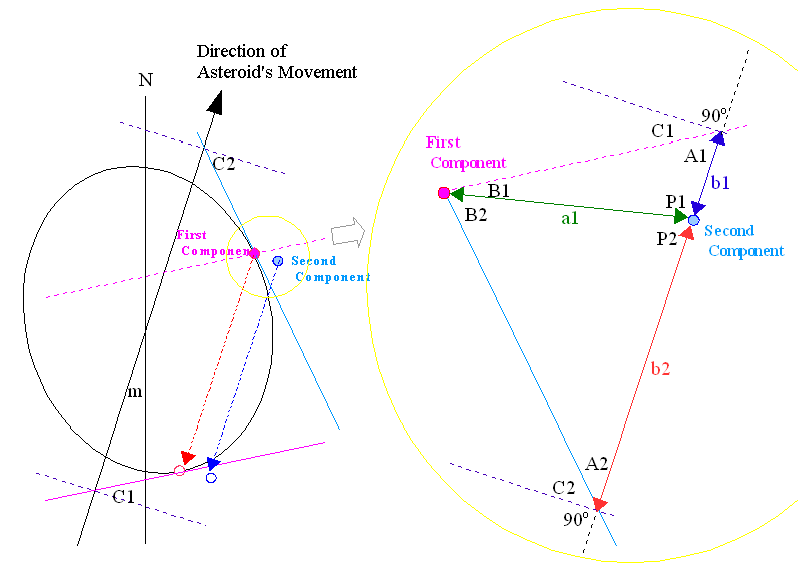
Figure
6 Geometry of double star's ocultation
The
position angle and separation of double star's components are able to
obtain from the observation of occultation event. The geometry is as
follows. In Figure 6 ,
a1 is separation between two components of
star.
P1 is the angle from the direction of asteroid's movement to
the direction of the straight line that passes by two
components.
Hence the position angle (P) is given:
P = m - P1
(or P=360-P1+m)
m is direction of asteroid's movement given as the
angular position from the direction of movement.
Following
parameters are necessary to estimate the astrometry of double star.
C1 is contact angle given as an angle between the direction of
asteroid's edge and the direction perpendicular to the direction of
asteroid's movement at the reappearance .
C2 is contact angle at
the disappearance obtained by same calculation as C1.
D1 is the
time difference from the time of reappearance of second component to
the time of reappearance of first component.
D2 is the time
difference from the time of disappearance of first component to the
time of diseappearance of second component..
A1,A2 is
given:
A1=90o-C1
A2=90o-C2
M is angular velocity of
asteroid's motion and B1,B2 are vertical angle of the triangles.
Then B1 is
given: (5)
(5)
Hence, P is given as:![]() or
or
![]() (6)
(6)
Separation (a1) is given as:![]() (7)
(7)
|
Deriving process From
law of sines.. Then a1 = b1*sinA1/sinB1 a1 = b2*sinA2/sinB2 b1*sinA1/sinB1
= b2*sinA2/sinB2 T=B1+B2 Substitute (f1) into (f3). ((b2*sinA2)/(b1*sinA1))*sinB1 = sinTcosB1-cosTsinB1 (b2*sinA2)/(b1*sinA1)
= sinT*cosB1/sinB1-cosT*sinB1/sinB1 |
The
position angle and separation is calculated using the formula
(5)-(7).
Tsutomu Hayamizu reduced the timing data reported from
observers. And Dave Herald also reduced data of this event and
obtained the feature of Kalliope asteroid:
Shape of Kalliope : 208.5 x 122.3km Linus : 38.3 x 16.7km
Separation 0.247" in PA 136.0 deg.
The chart of reduction indicate half the west of asteroid passed on the star, and the case of satellite is also similar. The order of the phenomenon was decided referring to the geometrical reduction of timing observation. It is thought that the positions of the components are as Fig.5.
The
contact angle (![]() )
of C1 and C2 is able to estimate by the diffraction fit process, as
mentioned above. In this case, it is considered that both components
of TYC 1886-01206-1 have same contact angle because the star is very
closed double and it is hidden by same place of the edge of asteroid.
)
of C1 and C2 is able to estimate by the diffraction fit process, as
mentioned above. In this case, it is considered that both components
of TYC 1886-01206-1 have same contact angle because the star is very
closed double and it is hidden by same place of the edge of asteroid.
The result of this processing is shown in Table 3 and Figure.7.
Table 3 Position angle and separation of components derived from each observation
|
Observer |
Event |
Component |
Limovie Analysis |
|
Tme Difference |
Contact Angle |
position angle |
Separation |
||
|
H |
M |
S |
|
milli sec |
Degree |
(degree) |
(milli arc sec) |
|||
|
Kalliope event |
||||||||||
|
Hiroyuki Tomioka |
D |
A |
19 |
48 |
57.293 |
|
200 |
-10.3 |
-59 |
0.62 |
|
D |
B |
19 |
48 |
57.493 |
|
|||||
|
R |
B |
19 |
49 |
24.307 |
|
97 |
48.0 |
|||
|
R |
A |
19 |
49 |
24.404 |
|
|||||
|
Hikaru Sato |
D |
A |
19 |
49 |
18.210 |
|
259 |
65.7 |
-69 |
0.51 |
|
D |
B |
19 |
49 |
18.469 |
|
|||||
|
R |
B |
19 |
49 |
44.205 |
|
152 |
70.7 |
|||
|
R |
A |
19 |
49 |
44.357 |
|
|||||
|
Shigeo Uchiyama |
D |
A |
19 |
48 |
57.361 |
|
311 |
61.8 |
-52 |
0.79 |
|
D |
B |
19 |
48 |
57.672 |
|
|||||
|
R |
B |
19 |
49 |
17.972 |
|
71 |
69.3 |
|||
|
R |
A |
19 |
49 |
18.043 |
|
|||||
|
Mitsuru Kashiwagura |
D |
A |
19 |
49 |
37.118 |
|
208 |
65.0 |
-74 |
0.41 |
|
D |
B |
19 |
49 |
37.326 |
|
|||||
|
R |
B |
19 |
49 |
54.466 |
|
0 |
39.0 |
|||
|
R |
A |
19 |
49 |
54.466 |
|
|||||
|
Linus event |
||||||||||
|
Katsuhiko Kitazaki |
D |
A |
19 |
48 |
1.178 |
|
153 |
30.9 |
-44 |
0.60 |
|
D |
B |
19 |
48 |
1.331 |
|
|||||
|
R |
B |
19 |
48 |
6.339 |
|
98 |
29.0 |
|||
|
R |
A |
19 |
48 |
6.437 |
|
|||||
|
Eisaku Katayama |
D |
A |
|
|
|
|
170 |
47.6 |
-52 |
0.55 |
|
D |
B |
|
|
|
|
|
|
|||
|
R |
A |
|
|
|
|
88 |
16.7 |
|||
|
R |
B |
|
|
|
|
|
|
|||
|
Masahisa Yanagisawa & Kenta Gonsho |
D |
A |
19 |
48 |
0.392 |
|
184 |
27.3 |
-65 |
0.77 |
|
D |
B |
19 |
48 |
0.576 |
|
|
|
|||
|
R |
A |
19 |
48 |
5.368 |
|
66 |
28.5 |
|||
|
R |
B |
19 |
48 |
5.434 |
|
|
|
|||
|
Satoshi Suzuki |
D |
A |
19 |
47 |
55.885 |
|
292 |
50.3 |
-51 |
0.91 |
|
D |
B |
19 |
47 |
56.177 |
|
|
|
|||
|
R |
A |
19 |
47 |
59.862 |
|
141 |
20.8 |
|||
|
R |
B |
19 |
47 |
59.906 |
|
|
|
|||
|
Average |
-58 |
0.65 |
||||||||
|
Stdev |
10 |
0.17 |
||||||||
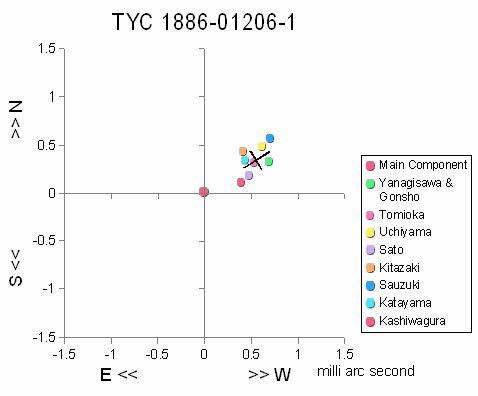
Figure.7
The astrometry of components derived from each observation
The gamma effect is corrected using the informations from observers.
Result of the analyzing and consideration is:
position
angle is -58 +/- 10![]() ,
separation is 0.65 +/- 0.17 milli arc second
,
separation is 0.65 +/- 0.17 milli arc second
(5) Astrometry using OCCULT 3.6
The timing data of Linus event obtained using Limovie's diffraction analysis were reduced by OCCULT 3.6. Fig,8-1 shows the shape of satellite and astrometry of double star components.
|
|
|
|
Fig8-1 Linus event Observed by.. 1,2: M.Yanagisawa & K.Gonsho, 3,4: K.Kitazaki, 5,6: S.Suzuki |
Fig.8-2 Kallliope event 1,2: H.Tomioka, 3,4: H.Sato, 5,6: S.Uchiyama, 7,8: M.Kashiwagura |
|
Fig.8 Reducing plot using OCCULT. |
|
The result of this reduction is:
position
angle is -63.7 +/- 3.4![]() ,
separation is 0.8 +/- 0.0 milli arc second
,
separation is 0.8 +/- 0.0 milli arc second
This is well corresponding to the result of the diffraction analysis. On the other hand, in the analysis of Kalliope event, the observed point does not well fitted the simulated ellipse. I asked to Dave Herald why this difference had occurred. He says ”The problem is that if the chords only cover one half of the asteroid, one of the axes is indeterminate. And this is the case for both Kalliope and Linus. An unfortunate coincidence....”. Fig.8-2 shows the comparison between direction of asteroid edge which is obtained from contact angle by diffraction method and reducing plot by OCCULT. On the side of disappearance, the direction well fit to the simulated ellipse. However, on the reappearance side, the direction differs from ellipse. The cause of it is not clarified yet. At present, in Kalliope event, the order of the phenomenon shown in the row of component in Table 3 is assumed, and the position is calculated.
4. Conclusion
TYC 1886-01206-1 is a double star which has two components separated 0.65 milli arc second from each other. The diffraction analysis of double star is able to determine the accurate time of each star's event and also be able to estimate the contact angle of each event.
And the position of each components of double star is estimated with comparatively high accuracy.
The following is given as notes this method is applied:
The gamma correction which was processed by the video camera makes difficulty in this diffraction method. However the gamma correction is often used to observe the faint star , because it makes the image of stars easy to distinguish. Therefore, it is need the function for Limovie to re-correct gamma effect to analyzing by this method more accurately. Limovie 0.9.25c has gamma re-correct function ,and obtains an excellent result in the analysis. In doing this method, it is important to confirm the order of component by using the reduced chart of the time data.Because the information which inclined, right or left, the edge of asteroid is not indicated.
There were several reports that the stepwise light-curve was found at the asteroidal occultation. Analyzing such video clips by this method, it is expected to be able to obtain several information of the detail of the double star.
Reference
Hayamizu,T 2006. The reduction of occultation by Kalliope and Linus. http://uchukan.satsumasendai.jp/data/occult/0611kalliope.html
Miyashita, K et al. 2006, Report of the National Astronomical observatory of Japan, 9, 1-26, (in Japanese) http://library.nao.ac.jp/naoreport/9-12.pdf
Richmond. M, 2005. Diffraction effects during a lunar occultation. http://spiff.rit.edu/richmond/occult/bessel/bessel.html
Kruczkowski,S. 2003. Fresnel Diffraction - a way of development of occultation project, Paper of ESOP XXII 2003. http://www.t1t-trebur.de/esop-2003/kru1.htm